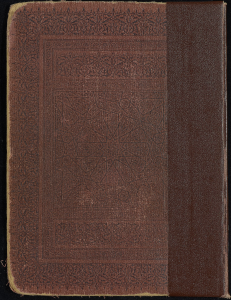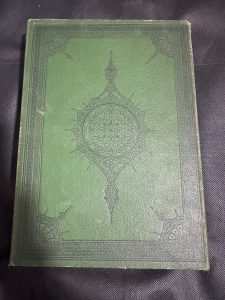

The 1924 Egypt Amīrī Qurʾān
This is one of those important editions of the Qurʾān that had an impact on the Qurʾān that was printed in the Eastern Arab world. Just about every muṣḥaf that is printed owes a great debt to this edition. It was widely reprinted: Kuwait, Jordan, Qatar, and Saudi. It was used as the template to correct other printed Quran such as shamarli and Uthmān Ṭahā Qurʾān that was used by the Qurʾān Printing Complex (QPC) in Medina. This edition is no longer important as the printing of QPC has surpassed it since the late 1980s. Many countries have printed their own text of the Qurʾān that come from a well established tradition, namely Morocco (Arab west which includes countries west of Libya), Ottoman /Turkey and Indian subcontinent.
links to download this muṣḥaf:
- Small sized (205 x 152 mm) info : high resolution link, low resolution link.
- 1952 edition Small sized (205 x 152 mm) info: high resolution link, low resolution link.
The 1924 Amīrī Qurʾān
The King Fuʾād muṣḥaf / Qurʾān[1] (hereinafter KFQ), also called al-Muṣḥaf al-Amirī or “Cairo edition,” was composed at the Amiriyyah press at Būlāq[2] in 1924 as it was charged with preparing the muṣḥaf and from the colophon we are able to gather information on its printing. The actual printing and binding took place at Giza, where the press that prints land survey. So technically it’s not Cairo printed Qurʾān but the composition as well as the review of the proofs were done in Cairo
Due to the shortcomings of the muṣḥaf Mukhalātī a team of experts was assembled to create a better edition of the text of the Qurʾān. Also from the documented history of the press we have additional information on this edition. Further a conference held in Cairo on 16–17 of October 2021 at Dominican Institute for Oriental Studies entitled: “The Cairo Edition of the Qurʾān 1924: Texts, history & challenges.”[3] All have further highlight the importance of this definitive edition of the text of the Qurʾān.
In the standard format it was printed with 12 lines per page and a wopping total of 827 pages and it came in two trim sizes, a large format (270 x 180 mm) on heavier paper stock and a smaller trim size (205 x 152 mm) light paper stock for primary school distribution.[4] The words were generously spaced apart as to avoid reading errors for first time readers unfamiliar with the Qurʾān.
As stated in the afterword on this printing (see pages followingthe last numbered page of the text after p.827) that the text follows the Ḥafṣ recitation mode narrated on the authority of Ḥafṣ b. Sulymān b. al-Mughīra al-ʾĀsadī (d. 180/796) from ʿĀṣim b. Abī al-Nujūd al-Kūfī (d. 127/745)[5] from Abū ʿAbd al-Raḥmān ʿAbdullah b. Ḥabīb al-Sulamī (d. 74/694) from the following companions: ʿUthman b. ʿAffān (d. 35/656) , ʿAlī b. Abū Ṭālib (d. 40/661) , Zaīd b. Thābit (d. 45/665) and Ubayy b. Kʿaab (d. 33/654) all who received it from the Prophet Muḥammad (may the blessings and Peace of God be upon him) (d. 11/632). As for its spelling it was taken from the scholars of orthography, rasm, from the codices (muṣḥaf) that were sent out by the command of ʿUthman b. ʿAffān to Basra, Kufa, Shām (Damascus), Mecca, the codex that he assigned to the people of Medina and the codex that he kept for himself in addition to the codices that were copied directly from those six mentioned.
There are some letters about which there are disagreement (among narrators) about how those letters should be written out and those we followed the majority opinion and taking into account the recitation to how to render it in print and in following the principles that was established by the scholars of rasm (orthography) from the various/differing spellings according to what was narrated by Abū ʿAmr ʿUthmān b. Saʿīd al-Dāni (d. 444/1053) and Abū Dāwūd Sulymān b. Najāḥ al-Mūʾiyydī (d. 496/1103) and following Abū Dāwūd when they disagreed.[6] On the whole every letter included in the Amīrī muṣḥaf’s text is in agreement with one of the six ʿUthmānic codices based on what was established by Muḥammad b. Muḥammad b. Ibrāhīm al-ʿUmawī al-Sharīshī (d. 718/1318) who is known as al-Kharāz in his poem mawrid al-ẓamʾān and its commentor ʿAbd al-waḥid b. Aḥmad b. ʿAlī b. ʿAshir al-Anṣāri al-Andalusī (d. 1040/1631).
Vowelization (ḍabṭ) was adopted from what was established by the scholars of vowelization as related by Abū ʿAbdullah Muḥammad b. ʿAbdullah al-Uamawī al-Tansī (d. 899/1494)[7] in his book al-Ṭarāz ʿala ḍabṭ al-Kharāz and by substituting Andalusian and Maghrabi notation with those of al-Khalīl b. Aḥmad al-Farāhīdī (d. 170/786) and those who adopted his notation among the mashāriqa (those in the east). The count[8] of ayāt is adopted from the Kufan system on the authority of Abū ʿAbd al-Raḥmān ʿAbdullah b. Ḥabīb al-Sulamī from ʿAlī b. Abū Ṭālib as noted in Abū Muḥammad Qāsim b. Fīra b. Khalaf b. Aḥmad al-Shāṭibī (d. 590/1194) in his Nāẓimat al-zahar and its commentary by Abū ʿĪd Riḍwān b. Muḥammad b. Sulymān al-Mukhalāltī (d. 1311/1893) and by their count 6,236 āya. The divisions (juzʾ) in 30 parts, and into 60 sections (hizb) and into quarters is based on ʿAlī al-Nūrī b. Muḥammad al-Safāqisī (d. 1118/1706) as noted in his Ghayth al-nafʿ and commentary taḥqīq al-bayān and Irshād al-qurāʾ wa-lkātibīn by Riḍwān al-Mukhalāltī.
Notes:
[1] I am aware of Gotthelf Bergsträsser’s 1932 article “Koranlesung in Kairo” in ,” Der Islam 20 (1932): 2-13 on this and I cover the same ground therefore for the sake of completeness I am including this materiel here. I personally/physically examined similar copies of the muṣḥaf that he described in his article to confirm his findings and for the sake of this article. Where this article includes is additional material on the edition of 1950’s which corrected few remaining issues as will be discussed in detail.
[2] Būlāq, northwestern district of Cairo, Egypt. Situated on the Nile River, Būlāq was a major port suburb before the city of Cairo expanded to engulf it. (Encyclopedia Brittanica). The proximity to the river was needed to facilitate the transport the heavy machinery needed for the press and constant supply of metal, paper and ink.
[3] Sources for the history in Western language include Nöldeke, schwally, et. al., The History of the Qurʾān, Leiden: Brill, 2013, 603-4; On the typography see Nemeth, Titus, Arabic Type-Making in the Machine Age, Leiden: Brill, 2016, 160-163; Nemeth, Titus, eds. Arabic Typography: History and Practice, pp. 53-55.
[4] This is based on anecdotal evidence and first hand access to two copies, one printed in 1343/1924 (relief stamp on page 1 and 2) in the larger page size and another in smaller page size 1344(1925) colophon and blue ink rubber stamp dated 1345. Additionally, first hand access to two other copies from the 1950’s in these two sizes. Most pages are 12 lines with the exception of the facing pages of sūra 1 and sūra 2 (6 lines per page). Also pages that include a sūra title are 9 lines see sūra 3 and following. The decorative element and sūra name, place of revelation take up 3 lines of text. The 12 line system breaks down to less lines per page in part 30. So when I mention 12 lines I mean that in a full page of text has 12 lines of text. The typeface size of the text is only slightly smaller for the smaller size, the page margins are generous, 4 – 5 cm / 1.5–2 in, in the larger edition whereas the primary school edition has less border 2 cm / ¾ in. This trim size was followed in the 1952 printed editions as well. Finally the afterword to the second edition of 1952 is only found in the larger sized muṣḥaf. This is important to note because later reprints KFQ reprint the 1952 primary school edition that is without the updated afterword, which led many to believe that they are reading the early 1924 edition.
[5] The dates are from, Aymān Rushdī Sawiyyd, al-Tajwīd al-Muṣawar. Beirut: Dār al-Ghawthānī 2022, 12.
[6] Note that Abū Dāwūd was Abū ʿAmr’s most devoted student.
[7] His family hails from Andalusia of Umayyad decent. Ténès is a town on Mediterranean coast 204 kilometers west of the capital Algiers. The actual book title is al-Ṭarāz fī sharḥ ḍabṭ al-Kharāz ed. Aḥmad Sharshāl, KFQPC Medina, Saudi Arabia, 1420/1999.
[8] The count here does not mean just how to count an aya but where the aya ends and thus coming up with a count. For example everyone agrees on Sura 4 has 176 ayāt according the Kufan system, 177 according the Shāmī system and 175 for the others, its just where one aya starts and at what word it ends is what determines the overall count. See al-Mukhalati’s muṣḥaf, 42.